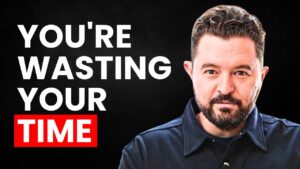“Your LinkedIn reputation isn’t entirely fragile. You can make a few mistakes, like hitting publish before editing or adding the wrong link. These are mistakes your audience can look over, as long as they’re not happening all the time.” Posted on the DigitalMarketer.com blog.
Interesting article regarding: 5 Ways to Ruin Your LinkedIn Reputation by the Digital Marketer Team that I found on the DigitalMarketer.com blog.
*Caveat: All images, videos, audios & content are the property of their respective owners/authors. If they fail to appear because they have been moved or removed, you can here.

We’re not talking about the mistakes that turn the grammar police on you or make you facepalm.
We’re talking about the mistakes that ruin your LinkedIn reputation and make your audience unfollow you and never engage with your posts. These are the mistakes that train your audience to assume bad content from you, not only ruining your LinkedIn reputation but your personal brand and company’s reputation too (yikes).
These are easy mistakes to make and just as easy to avoid, which means you have no excuse to make them after reading this article.
You are allowed to make grammar mistakes, though…because nobody’s perfect.
#1: Forgetting to Optimize Your Profile
Your content can make people think you’re a genius. Or it can make them wonder why you let your toddler write it for you. If you’re such an expert, your profile needs to reflect that.
Optimizing your profile is (cue a phrase marketers loveeee to use) like collecting that delicious low-hanging fruit. It doesn’t take a huge amount of effort and it only helps you in the end. It’s like giving your viewers the sugar rush of eating a perfectly ripe mango—that you picked by simply lifting your arm and pulling it off the tree.
Here’s the journey your viewers take every day on LinkedIn:
- Your content shows up in their feed
- They click on your profile to learn who you are
- They judge you
That last part is the harsh truth (and you do it too!). If someone’s profile isn’t consistent with the advice, stories, or strategies they share in their content—you won’t trust them. You need proof that they actually know what they’re talking about. And that’s why your profile is so important.
Take these 5 tips to easily implement your LinkedIn profile:
#1: Stop using terrible profile photos
#2: Delete ‘ninja’ from your headline
#3: Tell people it’s your birthday
#4: Create a narrative summary
#5: Boast about how great you are in the experience section
#2: Disregarding The Foundation of Branding

The foundation of branding comes down to people knowing who you are. Your brand tells them what to expect from you. As a company or personal brand, they’ll learn to expect you to be:
- Funny or professional
- Niche or general
- Strategic or pure fluff
If you post about your dog one day, the interior design of your home the next, and marketing the day after—people won’t be able to box you in. And in marketing, getting boxed in is a good thing.
You want people to be able to say, “I follow [Your Name] on LinkedIn and they always talk about X, Y, and Z. They’re a [title of your role].” Your audience can’t do that if you’re content bounces around more than one of those bouncy balls you buy from the $0.25 machines.
They can only do that if your content is like a bow and arrow that hits the target every time. That bullseye comes from your content pillars—the 3-5 topics you become notorious for talking about.
For example, if you’re a fractional CMO your content can talk about:
- Your marketing expertise (your strategies, thoughts, and experiences with marketing strategies)
- Why hiring a fractional CMO is better than hiring an internal CMO
- The results your clients are getting
Put yourself in a box and let your viewers label you as “that fractional CMO person.” It’ll put you top-of-mind when they read a post from a company owner looking to hire a fractional CMO.
Hellooooo fun work project opportunities.
#3: Never Adding Social Proof To Your Content
Don’t just talk the talk…walk the walk, too. Your LinkedIn reputation is on the line, and if you never prove that you know what you’re talking about—it’s only fair that your audience should question your expertise.
If you’re constantly posting big ideas but never backing up that you’re trying them out and taking action on them, your audience will put you in a box (see the section above). They’ll brand you as, “That person who doesn’t know what they’re talking about and is just posting to post.”
You never want to be that person. And on our watch, you won’t be.
Social proof is crucial for your marketing campaigns. Since LinkedIn is just part of your content marketing…that means social proof is also crucial for your LinkedIn presence.
Share your wins on the platform to make sure your audience knows that you don’t just talk about your expertise…you can back up that you know what you’re talking about.
Ben Wise, who’s accumulated over 200 million views on ghostwritten LinkedIn content, practices this strategy regularly. Here’s his post explaining why “Your story matters” and providing proof that people want to read about it:
When you add proof to your posts, you show that you’re not just another person trying to get attention on the platform. You’re a certified expert that knows what they’re talking about—and your viewers would be smart to work with you.
#4: Consistently Tagging Experts In Low-Quality Posts
Tagging experts in posts can help your post get seen by their audience. But, it’s a dangerous game. You can easily squash your reputation if you keep tagging experts in half-baked, low-quality posts.
You never want the experts in your industry (the people who can help you grow your business!) to see a notification about a post you tagged them in and think, “I wish this person would STOP tagging me.”
You always want them to think, “Wow, I wonder what they shared this time!”. With insightful posts that promote their content, you’ll make quick internet friends with even the highest-profile people in your industry.
And that’s the end goal of LinkedIn. Sure, the views are exciting. But views don’t put food on the table, a roof over your head, or money in your bank account. Views have to turn into business—and they can’t turn into dollars if your audience rolls their eyes at every post they see from you.
When you tag experts, make sure that you’re not only promoting their content and/or expertise but you’re adding your own take to what they have to say. Give them a reason to want to comment and engage with your post (and want to connect with you!).
A good rule of thumb is to ask yourself this question before you hit publish on a post that you’ve tagged an expert in:
If I was tagged in this post, what would be my reaction?
You’re looking for:
- “I would think that it’s brilliant and would reshare it because my audience would love to see this.”
- “I would definitely thank the person for creating such a thoughtful response to my content.”
- “I would reach out to this person to see if there’s a way we can work together.”
#5: Being Lazy With Your Repurposing Strategy
We love a great repurposing strategy. It saves time, money, and your team conserving resources that you can allocate to another part of your business that needs attention.
Your Instagram content should make its way to LinkedIn. Your tweet thread would be great as a post. But, there’s a right way and a wrong way to repurpose your content from other platforms to LinkedIn.
→ If you do this right, you’ll spend less time making content and get more views (and hopefully conversions).
→ If you do this wrong, people will learn to gloss over your posts and your reputation will be ruined.
This always comes down to having a lazy repurposing strategy. If you think that you can just copy and paste your tweet thread into LinkedIn and watch the virality ensue…you’re wrong. Your content needs to be tweaked for each platform. It doesn’t need a full rewrite, but it needs to fit the structure of what people expect to see on the platform it’s being published on.
For example, we turned our DM Insider newsletter into a tweet thread and a LinkedIn post. In this issue, we gave our subscribers the 6 steps to getting started with video ads. In our tweet thread, we outlined each step and even linked out to related articles we’d written.
But on LinkedIn, this would end up being way too long and the links wouldn’t make it reader-friendly. We repurposed our tweet thread with a few tweaks, like taking out the explanations of each step so that it was an easy-to-read post that our audience could like and save for later.
Don’t be tempted to hit copy and paste. Take a few minutes to make your content reader-friendly for each platform before you hit publish. If you don’t, you’ll train your audience to scroll past your content because it’s not reader-friendly and enjoyable to read.
Take your fingers off the CMD and V keys.
Don’t Ruin Your LinkedIn Reputation
You can easily avoid ruining your LinkedIn reputation by practicing these 5 tips. Don’t let a bad profile, a lack of branding, and low-quality posts hold back your business from finding success on the platform.
There are people using LinkedIn to find high-quality leads and network with experts in their industry. You can be one of them, as long as you’re not:
#1: Forgetting to Optimize Your Profile
#2: Disregarding The Foundation of Branding
#3: Never Adding Social Proof To Your Content
#4: Consistently Tagging Experts In Low-Quality Posts
#5: Being Lazy With Your Repurposing Strategy
And remember…occasional grammar mistakes and wrong links are acceptable.
What do you think? Share your thoughts in the comments below! If you would like to check the source or if the respective owners have moved the images, etc., displayed in this article, you can see them here.
5 Ways to Ruin Your LinkedIn Reputation
#DigitalMarketing #InternetMarketing


